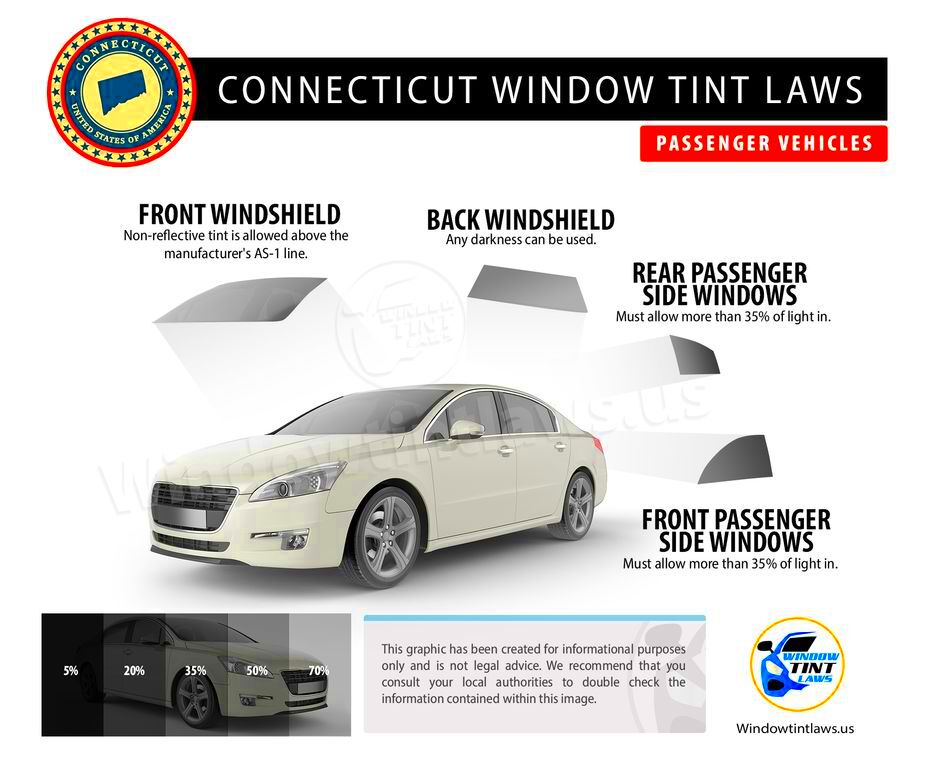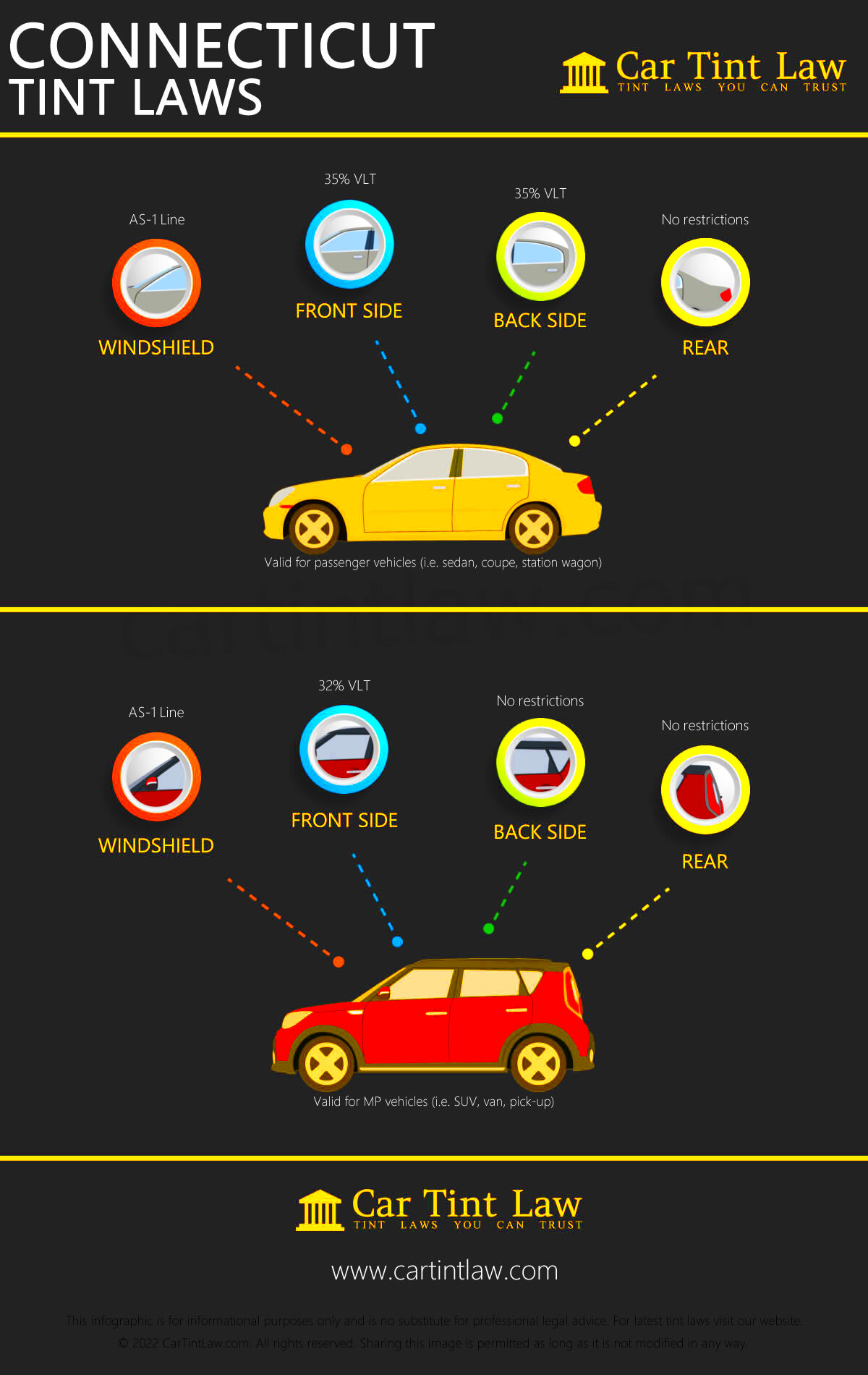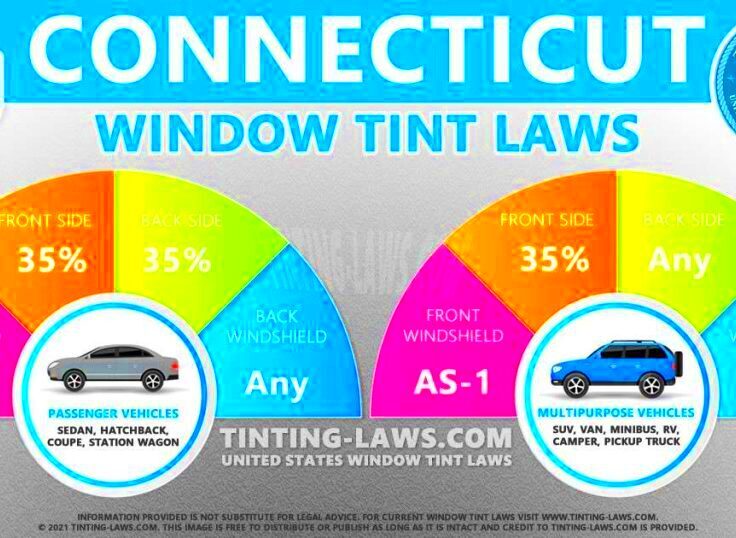Connecticut’s Window Tint Laws for Vehicles
When it comes to driving in Connecticut knowing the local laws can help you avoid fines and make sure your car is safe to be on the road. Window tinting may look good and serve a purpose but there are rules governing it in this state. Having spent some time living in Connecticut I’ve witnessed how a misinterpretation of these laws can result in costly tickets or even inspections for your vehicle. So lets explore what you should know about window tint regulations in Connecticut to keep your vehicle both compliant and cozy.
Legal Tint Limits for Different Windows

Connecticut has rules in place regarding the darkness of window tint. These rules aim to strike a balance between privacy and safety. Here’s an overview of what’s allowed.
- Front Side Windows: Must allow more than 70% of light to pass through. This is roughly equivalent to having a light tint that doesn’t significantly reduce visibility.
- Back Side Windows: You can have darker tints on these windows, but they must still allow at least 35% of light through. This provides some privacy while maintaining a reasonable level of visibility for others on the road.
- Rear Window: Similar to the back side windows, the rear window can be tinted to allow 35% light transmission. This means you can opt for darker tints without worrying too much about the visibility restrictions.
- Windshield: Tinting is only allowed on the top portion of the windshield above the AS-1 line, which is generally the area above the front seat area. This strip can be tinted to reduce glare but must allow at least 70% light transmission.
Keep in mind that these restrictions are set to make sure that drivers can see clearly, especially when the lighting is poor. Its wise to verify these limits with your nearby DMV or a qualified tint installer to steer clear of any issues.
Requirements for Tinting Materials and Colors

Connecticut has regulations regarding window tint that not only specify the level of darkness allowed but also govern the materials and colors that can be used. These rules are in place to ensure that the tint does not hinder safety features such as airbags or sensors. Drawing from my experience here are the key points you should be aware of regarding these requirements.
- Material: The tinting material must be of high quality and must not cause any distortion or interference with the view. Reflective or mirrored tints are generally not allowed, as they can be distracting to other drivers and may impair visibility.
- Color: Colors should be neutral and not excessively dark. While darker shades are permissible on rear and side windows, colors like red or blue are typically prohibited as they can reduce visibility and are often seen as a distraction.
- Certification: The tint film used must be certified and meet the manufacturer’s specifications for light transmission. Always ensure that the installer provides you with documentation that the tint adheres to Connecticut’s legal standards.
Using materials and following these color guidelines not only helps you stay within the law but also gives your vehicle a sleek and polished appearance. A piece of advice from someone who has faced tinting challenges is to seek the expertise of an installer who knows the local rules well.
Exemptions and Special Conditions for Window Tinting
Connecticuts regulations regarding window tinting are quite detailed however there are certain exemptions and special conditions that can simplify things for certain drivers. Having navigated the intricacies of these laws firsthand I can attest to how advantageous these exceptions can be particularly when you have specific requirements. Lets explore who could potentially gain from these exemptions and in what situations they may apply.
- Medical Exemptions: If you have a medical condition that requires additional protection from sunlight, you might qualify for a medical exemption. This typically involves conditions like severe photosensitivity or certain skin disorders. You’ll need to provide documentation from a healthcare provider and may need to get approval from the DMV.
- Commercial Vehicles: Certain commercial vehicles, especially those used for transporting goods or passengers, might be allowed more leniency with window tinting. However, this can vary based on the type of vehicle and its usage.
- Historical or Classic Cars: Classic cars that are more than a certain age might have different rules. If your vehicle qualifies, you might be able to use older tinting technologies that would otherwise be restricted.
- Law Enforcement and Emergency Vehicles: Vehicles used by law enforcement and emergency services often have different regulations. These vehicles may be allowed to use tints that would be illegal for civilian vehicles, owing to their specific operational needs.
While these exemptions can be helpful, they do come with the need for paperwork and authorization. If you think you meet the criteria for any of these exemptions it’s a good idea to reach out to your local authorities to confirm that you fulfill all the necessary conditions.
Penalties for Violating Window Tint Laws
Disregarding Connecticuts laws on window tint can result in consequences. Based on my own experiences and anecdotes from friends I’ve witnessed how quickly one can incur a fine or face penalties for not adhering to these rules. Here’s what you could encounter if your window tint doesn’t meet the standards.
- Fines: The most common penalty is a monetary fine. Depending on the severity of the violation, fines can range from $100 to $200. Repeated offenses may result in increased fines.
- Vehicle Inspections: In some cases, you might be required to have your vehicle inspected to verify compliance. This can be a time-consuming process and could involve additional fees.
- Order to Remove Tint: You may be issued a notice to remove the illegal tint. Failure to comply can lead to further penalties and complications with your vehicle registration.
- Points on Driving Record: Although not always the case, some violations might result in points being added to your driving record, which can affect your insurance rates and driving privileges.
Handling these fines can be a bit of a pain and might end up being expensive. It’s wiser to stay updated and make sure your window tinting complies with the law to steer clear of these problems.
How to Ensure Compliance with Connecticut’s Tint Laws
Ensuring that you adhere to Connecticut’s regulations on window tinting doesn’t need to be an overwhelming challenge. By taking approach and putting in some effort you can reap the rewards of tinted windows without running into any legal issues. Here’s a helpful guide to keep you on the side of the law.
- Know the Limits: Familiarize yourself with the legal tint limits for each type of window on your vehicle. Regularly check the latest regulations as they can be updated.
- Choose a Reputable Installer: Work with a professional tint installer who is well-versed in Connecticut’s laws. They can help you select the right materials and ensure that your tint is applied within legal limits.
- Request Certification: Ensure that the tinting materials used are certified and meet state requirements. Keep all documentation provided by the installer as proof of compliance.
- Conduct Regular Checks: Periodically check the condition and effectiveness of your window tint. If you notice any issues, address them promptly to avoid legal complications.
- Consult the DMV: If in doubt, contact the DMV or local law enforcement to clarify any questions about tinting regulations and to verify that your tint is within legal limits.
By following these guidelines you can relish in the coziness and seclusion that window tinting brings while adhering to Connecticuts regulations. Keep in mind that taking some measures in advance can spare you from possible inconveniences later on.
Steps to Take if You Receive a Tint Violation Ticket
Receiving a ticket for window tint can be quite an annoyance, particularly when you believed your tint was within the limits. Based on my encounters with traffic regulations I’ve come to realize that approaching these situations in a manner can really impact the outcome. If you ever find yourself facing a tint violation ticket here’s a guide to assist you through the process.
- Review the Ticket: Start by carefully reading the ticket to understand the specific nature of the violation. Check the details like the section of the law you’ve violated and any noted issues with the tint level.
- Document Your Tint: Take clear photographs of your window tint, ensuring they show the level of darkness and the condition of the tint. This documentation can be useful if you need to contest the ticket or prove that your tint was compliant.
- Consult a Professional: If you’re unsure about the legal limits or the specifics of your tint, consider consulting a professional or legal expert. They can offer advice on whether your tint was within the legal limits or if there might have been an error.
- Fix the Issue: If your tint is indeed out of compliance, arrange to have it corrected as soon as possible. This might involve removing or replacing the tint. Keep all receipts and records of any modifications made to your vehicle.
- Attend the Hearing or Court Date: If required, attend the court or hearing date mentioned on the ticket. Present your case, including any evidence that supports your compliance or actions taken to rectify the situation.
- Pay the Fine: If you’re unable to contest the ticket successfully, ensure you pay the fine promptly to avoid additional penalties or complications.
Dealing with a ticket for a window tint violation can save you both time and hassle. By following these steps you can handle the situation in a way and make sure you get back on the right side of the law.
Common Myths and Misconceptions About Window Tint Laws
Navigating the world of window tinting can be quite challenging with its array of regulations and rumors. Throughout my experiences, I’ve encountered numerous misunderstandings some of which can cause confusion or even unintentional breaches of the law. Here are some prevalent myths surrounding window tint regulations along with the facts that debunk them.
- Myth: Darker Tints Are Always Illegal. Many believe that any tint darker than a certain shade is automatically illegal. In reality, the legality of window tint depends on how much light it allows through, not just the darkness of the tint.
- Myth: All Tints Are the Same. Not all window tints are created equal. The materials and quality of the tint film can affect its legality. Some tints that might be legal in other states might not meet Connecticut’s specific regulations.
- Myth: You Can Get Away with Illegal Tint if You’re a Safe Driver. Compliance with tint laws is separate from driving behavior. Even if you are a cautious and safe driver, having illegal tint can still result in a violation.
- Myth: The Tint Laws Don’t Apply to Classic Cars. While classic cars might have some leeway, they still need to comply with current tint regulations. The rules can vary, but ignoring them can still lead to trouble.
- Myth: You Don’t Need to Worry About Tint on the Back Windows. Some people think that back window tinting is less regulated, but it’s crucial to follow the same rules for all windows to avoid fines.
Knowing the truth behind these misconceptions can assist you in making well informed choices regarding the tinting of your vehicles windows. Being aware of the facts is crucial to avoid being taken by surprise due to misunderstandings.
Frequently Asked Questions
When it comes to the regulations surrounding window tinting there are often inquiries regarding what is permissible and what is not. Drawing from my own experiences and discussions with other motorists here are some of the commonly asked questions regarding window tinting in Connecticut.
- Q: What is the legal limit for window tint on front side windows in Connecticut?
A: The legal limit is 70% light transmission. This means the tint must allow at least 70% of light to pass through the window. - Q: Can I apply a darker tint if I have a medical condition?
A: Yes, if you have a medical condition that necessitates darker tinting, you can apply for a medical exemption. You’ll need to provide appropriate documentation and approval from the DMV. - Q: Are there any restrictions on tint color in Connecticut?
A: Yes, the color of the tint should be neutral and not excessively dark or reflective. Colors like red or blue are generally not allowed as they can be distracting and reduce visibility. - Q: What should I do if I receive a tint violation ticket?
A: Review the ticket, document your tint, consult a professional if needed, correct the issue if necessary, and attend any required hearings or court dates. Ensure you pay any fines promptly to avoid additional penalties. - Q: Can I tint the rear window of my vehicle?
A: Yes, you can tint the rear window, but it must allow at least 35% of light through. Make sure to follow all local regulations to avoid fines.
These frequently asked questions tackle some of the worries people have regarding tinting. If you have more queries or require clarification reaching out to local authorities or an expert can offer you insights.
Conclusion
Navigating the window tint laws in Connecticut may initially seem daunting but it’s essential for avoiding penalties and ensuring your vehicle adheres to legal requirements. Based on my experiences I’ve discovered that staying updated and collaborating with reliable experts can make a significant difference. Whether it’s being aware of the tinting limits knowing about exemptions or handling violations having precise and information is crucial. The aim is to enhance your driving experience while staying within the boundaries of the law. By following the rules and being proactive you can enjoy the perks of window tinting without the hassle of legal complications. Keep in mind that a bit of knowledge and readiness can go a long way in keeping your vehicle both fashionable and compliant.


